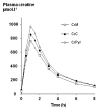Comparison of new forms of creatine in raising plasma creatine levels
- PMID: 17997838
- PMCID: PMC2206055
- DOI: 10.1186/1550-2783-4-17
Comparison of new forms of creatine in raising plasma creatine levels
Abstract
Background: Previous research has shown that plasma creatine levels are influenced by extracellular concentrations of insulin and glucose as well as by the intracellular creatine concentration. However, the form of creatine administered does not appear to have any effect although specific data on this is lacking. This study examined whether the administration of three different forms of creatine had different effects on plasma creatine concentrations and pharmacokinetics.
Methods: Six healthy subjects (three female and three male subjects) participated in the study. Each subject was assigned to ingest a single dose of isomolar amounts of creatine (4.4 g) in the form of creatine monohydrate (CrM), tri-creatine citrate (CrC), or creatine pyruvate (CrPyr) using a balanced cross-over design. Plasma concentration curves, determined over eight hours after ingestion, were subject to pharmacokinetic analysis and primary derived data were analyzed by repeated measures ANOVA.
Results: Mean peak concentrations and area under the curve (AUC) were significantly higher with CrPyr (17 and 14%, respectively) in comparison to CrM and CrC. Mean peak concentration and AUC were not significantly different between CrM and CrC. Despite the higher peak concentration with CrPyr there was no difference between the estimated velocity constants of absorption (ka) or elimination (kel) between the three treatments. There was no effect of treatment with CrPyr on the plasma pyruvate concentration.
Conclusion: The findings suggest that different forms of creatine result in slightly altered kinetics of plasma creatine absorption following ingestion of isomolar (with respect to creatine) doses of CrM, CrC and CrPyr although differences in ka could not be detected due to the small number of blood samples taken during the absorption phase. Characteristically this resulted in higher plasma concentrations of creatine with CrPyr. Differences in bioavailability are thought to be unlikely since absorption of CrM is already close to 100%. The small differences in kinetics are unlikely to have any effect on muscle creatine elevation during periods of creatine loading.
Figures


Similar articles
-
A buffered form of creatine does not promote greater changes in muscle creatine content, body composition, or training adaptations than creatine monohydrate.J Int Soc Sports Nutr. 2012 Sep 13;9(1):43. doi: 10.1186/1550-2783-9-43. J Int Soc Sports Nutr. 2012. PMID: 22971354 Free PMC article.
-
In ovo feeding of creatine pyruvate alters energy reserves, satellite cell mitotic activity and myogenic gene expression of breast muscle in embryos and neonatal broilers.Poult Sci. 2017 Sep 1;96(9):3314-3323. doi: 10.3382/ps/pex150. Poult Sci. 2017. PMID: 28854747
-
In ovo feeding of creatine pyruvate alters energy metabolism in muscle of embryos and post-hatch broilers.Asian-Australas J Anim Sci. 2019 Jun;32(6):834-841. doi: 10.5713/ajas.18.0588. Epub 2019 Jan 2. Asian-Australas J Anim Sci. 2019. PMID: 30744365 Free PMC article.
-
Efficacy of Alternative Forms of Creatine Supplementation on Improving Performance and Body Composition in Healthy Subjects: A Systematic Review.J Strength Cond Res. 2022 Sep 1;36(9):2663-2670. doi: 10.1519/JSC.0000000000003873. Epub 2021 Feb 11. J Strength Cond Res. 2022. PMID: 36000773
-
Creatine as nutritional supplementation and medicinal product.J Sports Med Phys Fitness. 2001 Mar;41(1):1-10. J Sports Med Phys Fitness. 2001. PMID: 11317142 Review.
Cited by
-
Effects of a Single Dose of a Creatine-Based Multi-Ingredient Pre-workout Supplement Compared to Creatine Alone on Performance Fatigability After Resistance Exercise: A Double-Blind Crossover Design Study.Front Nutr. 2022 Jun 21;9:887523. doi: 10.3389/fnut.2022.887523. eCollection 2022. Front Nutr. 2022. PMID: 35799580 Free PMC article.
-
Creatine Supplementation in Women's Health: A Lifespan Perspective.Nutrients. 2021 Mar 8;13(3):877. doi: 10.3390/nu13030877. Nutrients. 2021. PMID: 33800439 Free PMC article. Review.
-
Creatine homeostasis and protein energy wasting in hemodialysis patients.J Transl Med. 2021 Mar 20;19(1):115. doi: 10.1186/s12967-021-02780-y. J Transl Med. 2021. PMID: 33743724 Free PMC article.
-
Pharmacokinetic Evaluation of a Single 5-Gram Bolus of Creatine Monohydrate Versus Two Other Creatine-Containing Investigational Products.Cureus. 2022 Apr 22;14(4):e24395. doi: 10.7759/cureus.24395. eCollection 2022 Apr. Cureus. 2022. PMID: 35619864 Free PMC article.
-
Effects of various dietary supplements on inflammatory processes in primary canine chondrocytes as a model of osteoarthritis.Can J Vet Res. 2019 Jul;83(3):206-217. Can J Vet Res. 2019. PMID: 31308593 Free PMC article.
References
-
- Harris RC, Söderlund K, Hultman E. Evaluation of Creatine in resting and exercised muscle of normal subjects by Creatine supplementation. Clin Sci (Lond) 1992;83:367–374. - PubMed
-
- Terjung RL, Clarkson P, Eichner ER, Greenhaff PL, Hespel PJ, Israel RG, Kraemer WJ, Meyer RA, Spriet LL, Tarnopolsky MA, Wagenmakers AJM, Williams MH. The American College of Sports Medicine Roundtable on the physiological and health effects of oral creatine supplementation. Med Sci Sports Exerc. 2000;32:706–717. doi: 10.1097/00005768-200003000-00024. - DOI - PubMed
-
- Williams MH, Kreider RB, Branch JD. Creatine: the power supplement. Champaign: Human Kinetics; 1999.
-
- Chanutin A. The fate of creatine when administered to man. J Biol Chem. 1926;67:29–41.
LinkOut - more resources
Full Text Sources
Other Literature Sources
